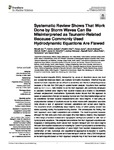Systematic Review Shows That Work Done by Storm Waves Can Be Misinterpreted as Tsunami-Related Because Commonly Used Hydrodynamic Equations Are Flawed
| dc.contributor.author | Cox, R | |
| dc.contributor.author | Ardhuin, F | |
| dc.contributor.author | Dias, F | |
| dc.contributor.author | Autret, R | |
| dc.contributor.author | Beisiegel, N | |
| dc.contributor.author | Earlie, CS | |
| dc.contributor.author | Herterich, JG | |
| dc.contributor.author | Kennedy, A | |
| dc.contributor.author | Paris, R | |
| dc.contributor.author | Raby, A | |
| dc.contributor.author | Schmitt, P | |
| dc.contributor.author | Weiss, R | |
| dc.date.accessioned | 2020-03-05T11:15:10Z | |
| dc.date.available | 2020-03-05T11:15:10Z | |
| dc.date.issued | 2020-02-05 | |
| dc.identifier.issn | 2296-7745 | |
| dc.identifier.issn | 2296-7745 | |
| dc.identifier.other | ARTN 4 | |
| dc.identifier.uri | http://hdl.handle.net/10026.1/15433 | |
| dc.description.abstract |
Coastal boulder deposits (CBD), transported by waves at elevations above sea level and substantial distances inland, are markers for marine incursions. Whether they are tsunami or storm deposits can be difficult to determine, but this is of critical importance because of the role that CBD play in coastal hazard analysis. Equations from seminal work by Nott (1997), here referred to as the Nott Approach, are commonly employed to calculate nominal wave heights from boulder masses as a means to discriminate between emplacement mechanisms. Systematic review shows that this approach is based on assumptions that are not securely founded and that direct relationships cannot be established between boulder measurements and wave heights. A test using an unprecedented dataset of boulders moved by storm waves (with associated sea-state data) shows a lack of agreement between calculations and actual wave heights. The equations return unrealistically large heights, many of which greatly exceed sea states occurring during the boulder-moving storms. This underscores the finding that Nott-Approach wave-height calculations are unreliable. The result is general, because although the field data come from one region (the Aran Islands, Ireland), they represent a wide range of boulder masses and topographic settings and present a valid test of hydrodynamic equations. This analysis demonstrates that Nott Approach equations are incapable of distinguishing storm waves from tsunami transport and that wave heights hindcast from boulder masses are not meaningful. Current hydrodynamic understanding does not permit reliable computation of wave height from boulder measurements. A combination of field, numerical, and experimental approaches is required to quantify relationships between wave power and mass transport onshore. Many CBD interpreted as tsunami deposits based on Nott-Approach analysis may in fact have been emplaced during storms and should therefore be re-evaluated. This is especially important for CBD that have been incorporated into long-term coastal risk assessments, which are compromised if the CBD are misinterpreted. CBD dynamics can be better determined from a combination of detailed field measurements, modeling, and experiments. A clearer understanding of emplacement mechanisms will result in more reliable hazard analysis. | |
| dc.format.extent | 4- | |
| dc.language.iso | en | |
| dc.publisher | Frontiers Media | |
| dc.subject | coastal boulder deposits | |
| dc.subject | storm waves | |
| dc.subject | tsunami | |
| dc.subject | hydrodynamic equations | |
| dc.subject | coastal erosion | |
| dc.subject | coastal hazard | |
| dc.subject | coastal geomorphology | |
| dc.subject | wave modeling | |
| dc.title | Systematic Review Shows That Work Done by Storm Waves Can Be Misinterpreted as Tsunami-Related Because Commonly Used Hydrodynamic Equations Are Flawed | |
| dc.type | journal-article | |
| dc.type | Review | |
| plymouth.author-url | https://www.webofscience.com/api/gateway?GWVersion=2&SrcApp=PARTNER_APP&SrcAuth=LinksAMR&KeyUT=WOS:000512880200001&DestLinkType=FullRecord&DestApp=ALL_WOS&UsrCustomerID=11bb513d99f797142bcfeffcc58ea008 | |
| plymouth.volume | 7 | |
| plymouth.publication-status | Published online | |
| plymouth.journal | Frontiers in Marine Science | |
| dc.identifier.doi | 10.3389/fmars.2020.00004 | |
| plymouth.organisational-group | /Plymouth | |
| plymouth.organisational-group | /Plymouth/Admin Group - REF | |
| plymouth.organisational-group | /Plymouth/Admin Group - REF/REF Admin Group - FoSE | |
| plymouth.organisational-group | /Plymouth/Faculty of Science and Engineering | |
| plymouth.organisational-group | /Plymouth/Faculty of Science and Engineering/School of Engineering, Computing and Mathematics | |
| plymouth.organisational-group | /Plymouth/REF 2021 Researchers by UoA | |
| plymouth.organisational-group | /Plymouth/REF 2021 Researchers by UoA/UoA12 Engineering | |
| plymouth.organisational-group | /Plymouth/Users by role | |
| plymouth.organisational-group | /Plymouth/Users by role/Academics | |
| plymouth.organisational-group | /Plymouth/Users by role/Researchers in ResearchFish submission | |
| dcterms.dateAccepted | 2020-01-07 | |
| dc.rights.embargodate | 2020-3-10 | |
| dc.identifier.eissn | 2296-7745 | |
| dc.rights.embargoperiod | Not known | |
| rioxxterms.versionofrecord | 10.3389/fmars.2020.00004 | |
| rioxxterms.licenseref.uri | http://www.rioxx.net/licenses/all-rights-reserved | |
| rioxxterms.licenseref.startdate | 2020-02-05 | |
| rioxxterms.type | Journal Article/Review |


